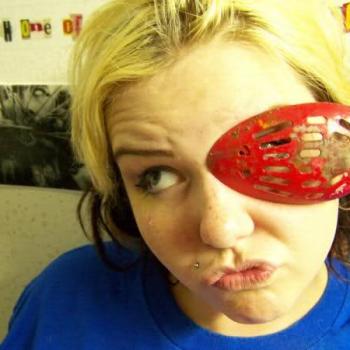We needed to get out the door, but Bobby was adamant—he didn’t want to go. He wanted to stay home and watch his favorite kids’ TV show. He worked hard to communicate and I understood what he wanted, but we really did have to get out the door. Bobby worked himself up into a frenzy and then began to cry. I picked him up and carried him to the car. By the time I buckled him into his carseat, he had accepted the inevitable. He was still upset, but he was much calmer.
 As I pulled out onto the road, I heard Sally whispering to her brother across the back seat, offering advice from her big sisterly wisdom and experience.
As I pulled out onto the road, I heard Sally whispering to her brother across the back seat, offering advice from her big sisterly wisdom and experience.
“Bobby, sometimes you have to do what you don’t want to do.”
—————————
From time to time a reader will leave a horrified comment on one of my positive parenting posts, asking how I can think that never saying no to my children is anything but terrible parenting. Except . . . I have never said that I never say no to my children. In this post, I want to talk a bit about how, when, and why I say “no” to my children, accompanied with some explanatory anecdotes.
—————————
I see authoritarian parenting and permissive parenting as two ends of a spectrum. On the one side, the desires of the parent are supreme and on the other side the desires of the child are supreme. Neither of these extremes are healthy. I see parenting as a relationship, and healthy relationships require give and take. I see positive parenting as something that falls between these extremes. There are still limits and boundaries, but these things are not arbitrary or dictatorial. There is give and take, back and forth, communication, cooperation, and compromise.
I see myself not as a dictator or task master but as a guide. As Sally’s guide, it is my job to prepare her for future adulthood. Sometimes I think of myself as a wilderness guide, taking a city-dweller into the forest, mountains, or desert with nothing but packs on our back. I have to keep my charge from danger, whether that be wild animals or sudden cataclysms or exposure, but I also have to teach him which plants can be eaten and which are poisonous, how to protect himself from the heat or the cold, how to find clean water, and how to walk without making a sound. I do not set myself up as a dictator over my charge, but I do know more than he does about the dynamics of the forest or the mountains or the desert. My role is not to dictate but to guide, side by side, walking the same steps, together.
—————————
Adults cannot have everything they want or avoid everything they would rather not do. Children cannot either, but they are not born understanding this dynamic and it can be hard for them to maneuver. Being able to successfully navigate likes and dislikes, desires and distastes, is something children must learn. Understanding when to accept the inevitable and when to push back is another important skill. As parent, I work to both affirm their feelings and passions and at the same time help them accept that there will always be some things they cannot have even if they want them and other things they cannot avoid even if they would like to.
“Sally, I understand that you want to buy that,” I’ll say. “And it looks really cool! But we don’t have money in the budget for it right now.” When she looks upset, I’ll go on: “I know honey, I know. Sometimes I want things I can’t have too. For instance, I would really like an iPad, but that’s a lot of money. Sometimes we want things but we can’t have them.”
“Sally, I know you don’t want to clean up the mess you just made,” I’ll say. “But someone has to clean it up, and you’re the one who made it, so it’s your responsibility.” With a smile, I’ll go on: “Sometimes I have to do things I don’t want to do too, you know. For instance, I don’t really like changing your brother’s diapers, but I still have to do it. Sometimes we have to do things we don’t want to do.”
This doesn’t go one way, and it’s not something that is applied unevenly. It’s not something I preach without practicing. It’s a give and take, and understanding that this is a more general principle, and not just something I say to make her do something she doesn’t want to do, helps Sally accept it.
—————————
“Mommy, can you get me a cup of milk?” Sally asks.
“Just a minute, let me finish this,” I reply, looking up from some work on my laptop.
“Okay.”
. . .
“Mommy, it’s been a minute.” And it has, but I’m still not finished.
“Hang on, almost done, so close,” I respond.
“Mommy, sometimes you have to do what you don’t want to do,” Sally tells me.
And she’s right, so I get up and get her her milk.
—————————
“Sometimes you have to do what you don’t want to do” is actually the easier concept for a child to understand. Accepting it may be a different matter, but understanding it isn’t so complicated. The harder thing to understand is when you have to do something you don’t want to do . . . and when you don’t. As an adult, these distinctions seem fairly clear. I do have to wash the dishes, but I don’t have to make okra. I do have to pay for car insurance, but I don’t have to drive to Phoenix. Where what I must do as a member of society ends and what I may choose whether to do as an individual begins is generally fairly clear. For children, this distinction can blur.
—————————
While out running errands recently, Sally came upon a fancy pink princess bike. We got her own bike second-hand from some friends. It’s blue and red and completely functional. And yet . . . a princess bike!
“Mommy, can I get this fancy new bike?” Sally asked. “Please please please!”
“Honey, you already have a bike,” I reminded her.
“I know!” she responded. “But this one is so fancy and I love it! I want a new bike!”
“Sally, let me see how I can explain this. I would love a new car. I really, really would. This car we have is old and, frankly, ugly. I would love a new car. But new cars cost money, and since we already have a car that works, we really don’t need a new one.”
“So when this car breaks we would get a new one?” Sally asked, clarifying.
“Yes,” I replied. “It doesn’t make sense to get a new car when the one we have already works. It’s not a good use of our money.”
“Ohhhh,” Sally breathed. “I understand. You don’t need to get a new one until the old one is broken. I understand, mom.”
“Good.”
“So I don’t need a new bike until my old one is broken.”
“Yes.”
—————————
Positive parenting isn’t about giving children everything they want or saying yes to everything they ask for. It’s about viewing children as people whose likes and dislikes matter, and who need to be treated as people and given the skills they need for adulthood. It’s about forming a relationship that involves both give and take and guidance rather than a top-down dictatorship. All of these pieces influence how, why, and when I tell my children “no.”













